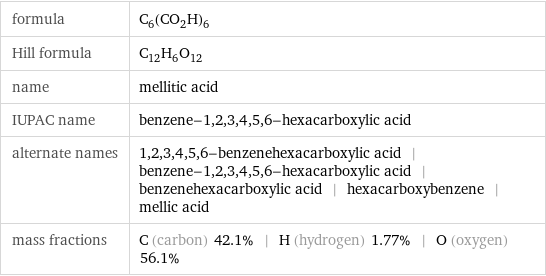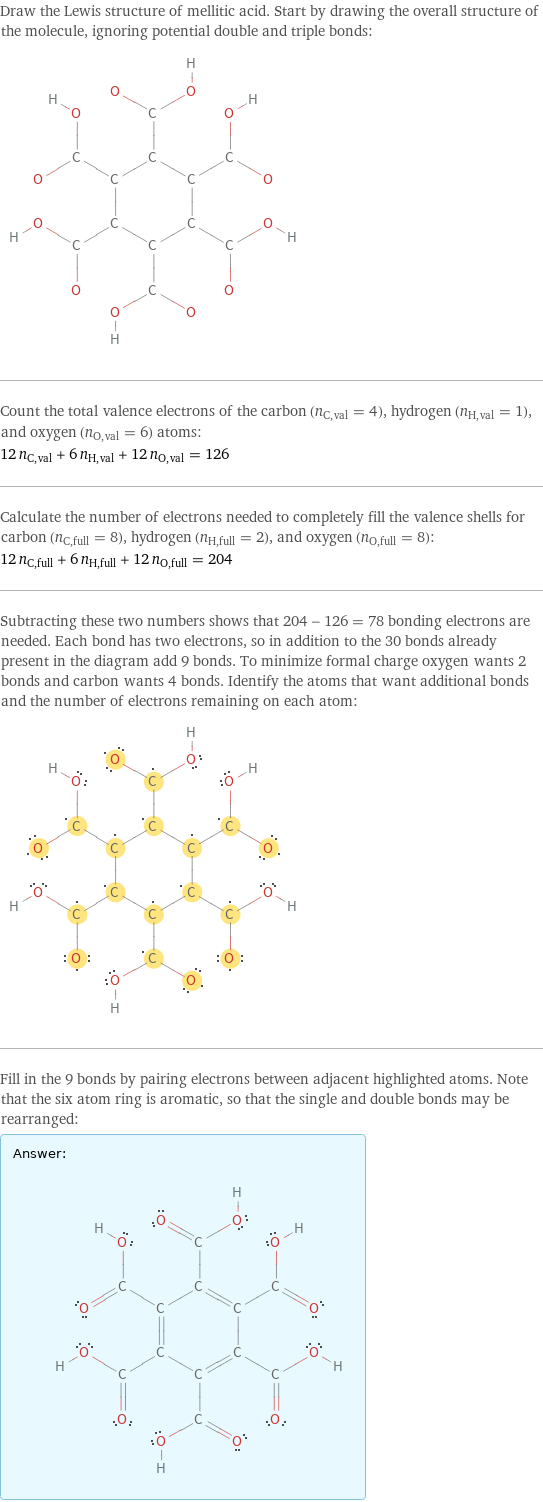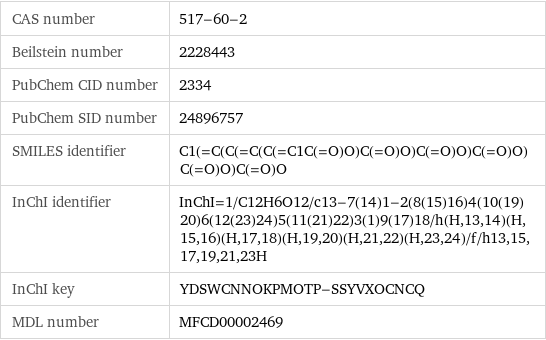Input interpretation

mellitic acid
Chemical names and formulas

formula | C_6(CO_2H)_6 Hill formula | C_12H_6O_12 name | mellitic acid IUPAC name | benzene-1, 2, 3, 4, 5, 6-hexacarboxylic acid alternate names | 1, 2, 3, 4, 5, 6-benzenehexacarboxylic acid | benzene-1, 2, 3, 4, 5, 6-hexacarboxylic acid | benzenehexacarboxylic acid | hexacarboxybenzene | mellic acid mass fractions | C (carbon) 42.1% | H (hydrogen) 1.77% | O (oxygen) 56.1%
Lewis structure

Draw the Lewis structure of mellitic acid. Start by drawing the overall structure of the molecule, ignoring potential double and triple bonds: Count the total valence electrons of the carbon (n_C, val = 4), hydrogen (n_H, val = 1), and oxygen (n_O, val = 6) atoms: 12 n_C, val + 6 n_H, val + 12 n_O, val = 126 Calculate the number of electrons needed to completely fill the valence shells for carbon (n_C, full = 8), hydrogen (n_H, full = 2), and oxygen (n_O, full = 8): 12 n_C, full + 6 n_H, full + 12 n_O, full = 204 Subtracting these two numbers shows that 204 - 126 = 78 bonding electrons are needed. Each bond has two electrons, so in addition to the 30 bonds already present in the diagram add 9 bonds. To minimize formal charge oxygen wants 2 bonds and carbon wants 4 bonds. Identify the atoms that want additional bonds and the number of electrons remaining on each atom: Fill in the 9 bonds by pairing electrons between adjacent highlighted atoms. Note that the six atom ring is aromatic, so that the single and double bonds may be rearranged: Answer: | |
Basic properties

molar mass | 342.17 g/mol phase | solid (at STP) melting point | 300 °C solubility in water | very soluble
Units

Hydrophobicity and permeability properties

experimental LogP hydrophobicity | 1.5 predicted LogP hydrophobicity | 1.01 predicted LogS | -3.23
Basic drug properties

approval status | experimental | small molecule
Solid properties (at STP)

vapor pressure | 4×10^-19 mmHg
Units

Thermodynamic properties

molar heat of combustion | 3300 kJ/mol specific heat of combustion | 9.64 kJ/g (at STP)
Chemical identifiers

CAS number | 517-60-2 Beilstein number | 2228443 PubChem CID number | 2334 PubChem SID number | 24896757 SMILES identifier | C1(=C(C(=C(C(=C1C(=O)O)C(=O)O)C(=O)O)C(=O)O)C(=O)O)C(=O)O InChI identifier | InChI=1/C12H6O12/c13-7(14)1-2(8(15)16)4(10(19)20)6(12(23)24)5(11(21)22)3(1)9(17)18/h(H, 13, 14)(H, 15, 16)(H, 17, 18)(H, 19, 20)(H, 21, 22)(H, 23, 24)/f/h13, 15, 17, 19, 21, 23H InChI key | YDSWCNNOKPMOTP-SSYVXOCNCQ MDL number | MFCD00002469